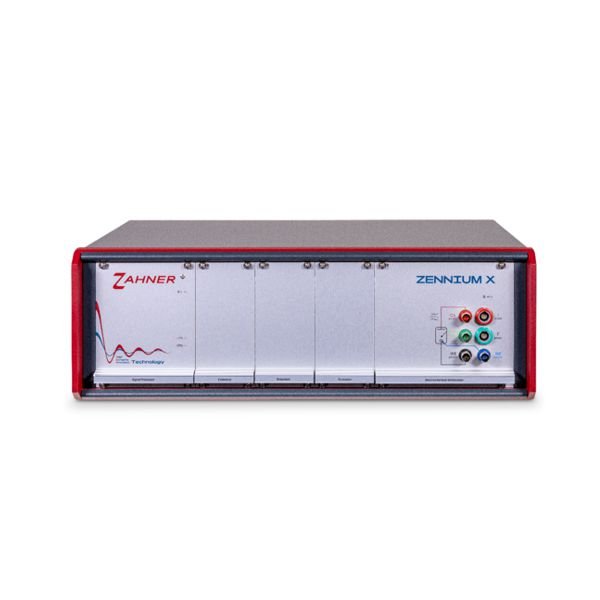
get a quote
The ZENNIUM X potentiostat offers 32 bit DC resolution and 24 bit AC resolution across 12 different current ranges, which enables it to carry out outstandingly precise and accurate measurements.
Nine extension slots allow versatile customization of the potentiostat for use in different fields of electrochemistry.
Zennium X
Zahner-Elektrik
The ZENNIUM X is a modular potentiostat / galvanostat including a frequency response analyzer (FRA).The ZENNIUM X potentiostat offers 32 bit DC resolution and 24 bit AC resolution across 12 different current ranges, which enables it to carry out outstandingly precise and accurate measurements.
Nine extension slots allow versatile customization of the potentiostat for use in different fields of electrochemistry.
Specifications
• DC voltage ranges: ±5 V and ±15 V• Current up to ±4 A over 12 current ranges
• EIS frequency range from 10 µHz to 12 MHz
• AC amplitude of 0 - 6 V or 0 - 2 A for EIS
• Up to 17 parallel channels for EIS (4 PAD4 cards)
• Switchable floating / grounded mode
• ADF technology for fast CV (up to 10 kV/s)
General
| Overall bandwidth | DC - 15 MHz |
| ADC resolution | 32 bit |
| Harmonic reject* | > 60 dB @ ½ full scale |
| Potentiostat modes | potentiostatic, galvanostatic, pseudo-galvanostatic, OCP, ZRA, FRA |
| Cell connection | 2-, 3-, 4-terminal kelvin |
| Ground reference | grounded, floating |
| Extension slots | 10 |
| PC interface | USB 2.0 |
| Dimensions (H x W x D) | 160 x 470 x 376 mm3 |
| Weight | 13.2 kg |
| Accessories | cell cable set, USB cable, power cord, Testbox, Thales XT software suite, manual, 3 Zahner Analysis licenses |
| Power supply | 100/115/230VAC, 50/60Hz |
| Ambient temperature | +10 °C to +30 °C |
| Ambient humidity | < 60% without derating |
| Storage temperature | -20 °C to +85 °C |
Input
| Maximum input voltage | ±5.5 V | 5 V range |
| ±16 V | 15 V range | |
| Voltage resolution | 2.5 nV | 5 V range |
| 7.5 nV | 15 V range | |
| Voltage accuracy* | ±20 µV ± 2 ppm of reading | 5 V range |
| ±50 µV ± 5 ppm of reading | 15 V range | |
| Current resolution | ±2 aA (32 bit) | Main / HiZ Probe |
| Current accuracy* | ±0.05% of reading ± 0.01% of FS | 1 µA ... 100 mA |
| ±0.5% of reading ± 0.1% of FS | 100 mA ... 4 A | |
| ±0.5% of reading ± 0.1% of FS | 10 nA ... 1 µA | |
| ± 0.5% of reading, ± 125 fA | < |1 nA| HiZ Probe | |
| Input impedance* | > 10 TΩ || ±5 pF (typical) | Main |
| > 1000 TΩ || ±1 pF (typical) | HiZ Probe | |
| Input leakage current* | < |200 fA| typ. | |
| < |2 pA| max. | ||
| |10 fA| typ. | HiZ Probe | |
| Impedance range* | 1 mΩ to 10 GΩ / 1% | Main |
| 100 mΩ to 10 MΩ / 0.1% | ||
| 100 mΩ to 100 GΩ / 2% | HiZ | |
| 10 µΩ to 1 GΩ / 2% | Gal | |
| 1 mΩ to 10 MΩ / 0.2% | ||
| Common mode rejection* | > 86 dB @ 10 µHz to 100 kHz | |
| > 66 dB @ 100 kHz to 12 MHz | ||
| Input channel phase-tracking accuracy* | ±0.05 ° @ 10 µHz to 100 kHz | |
| ±0.125 ° @ 100 kHz to 12 MHz | ||
| Equivalent effective input noise* | 1 µV rms / 100 fA rms @ 1 mHz to 10 Hz | Main |
| 10 µV rms / 15 fA rms @ 1 mHz to 10 Hz | HiZ |
Output Potentiostatic
| Controlled voltage | ±5 V | |
| ±15 V | ||
| Resolution | 2.5 nV | 5 V range |
| 7.5 nV | 15 V range | |
| Accuracy* | ±50 µV ± 5 ppm of reading | 5 V range |
| ±200 µV ± 5 ppm of reading | 15 V range | |
| Integral Nonlinearity* | typ. 1 ppm, max. 2 ppm | 5 V range |
| typ. 3 ppm, max. 8 ppm | 15 V range | |
| Compliance voltage | ±16 V | |
| ±32 V | ||
| AC amplitude | 0 to 2 V, 24 bit resolution | 5 V range |
| 0 to 6 V, 24 bit resolution | 15 V range | |
| Bandwidth | 15 MHz @ 33 Ω load | |
| IR compensation | auto AC impedance technique | |
| range 0 to 10 MΩ | ||
| resolution 0.012% | ||
| Small signal rise time | 150 ns to 200 µs in 5 steps | automatic selection |
| Slew rate* | 15 MV/s | |
| Phase shift* | 10° @ 500 kHz |
Output Galvanostatic
| Maximum current | ±4 A | |
| Current range | ±1.9 nA to ±4 A in 12 steps | Main |
| Resolution | 32 bit, ±0.2 ppb of FS | |
| Accuracy* | ±0.025% of reading ± 0.01% of FS | ≥ 1 µA to 100 mA |
| ±0.1% of reading ± 0.05 % of FS | < 1 µA or > 100 mA |
Frequency Generator and Analyzer
| Frequency range | 10 µHz to 12 MHz |
| Accuracy* | < 0.0025% |
| Resolution | 0.0025%, |
| 10000 steps/decade |
Applications
For medium power applications, it is possible to extend the ZENNIUM X potentiostat with power potentiostats of the PP2X2 series for power applications up to 200 W. The XPOT2 adds bi-potentiostat functionality to ZENNIUM X potentiostat e.g., for RRDE setup.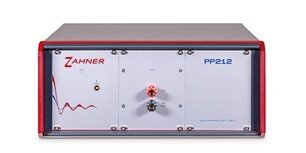 The PP212 is a 4-quadrant power potentiostat designed to apply and sink high currents up to ±10 A at a high voltage range of up to ±20 V (max. power output 200 W).
The PP212 is a 4-quadrant power potentiostat designed to apply and sink high currents up to ±10 A at a high voltage range of up to ±20 V (max. power output 200 W).For medium power applications, the PP212 is used as an extension of the ZENNIUM series potentiostat. Most electrochemical techniques which can be performed with the main ZENNIUM potentiostat can also be carried out with the extended power potentiostat PP212 setup.
Besides an extension, the PP212 power potentiostat can also be used in stand-alone mode for standard DC measurements i.e., charging/discharging of batteries. Zahner's new Zahner Lab software controls the potentiostat during stand-alone operations.
The Zahner's power potentiostats can be incorporated in a Python lab environment and can be used as stand-alone or in multi-channel configurations. A GitHub repository with examples is available for developing Python applications.
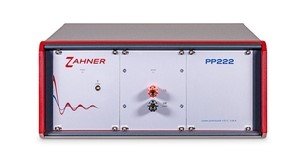 The PP222 is a 4-quadrant power potentiostat designed to apply and sink high currents up to ±20 A at a voltage range of up to ±10 V (max. power output 200 W).
The PP222 is a 4-quadrant power potentiostat designed to apply and sink high currents up to ±20 A at a voltage range of up to ±10 V (max. power output 200 W).For medium power applications, the PP222 is used as an extension of the ZENNIUM series potentiostat. Most electrochemical techniques which can be performed with the main ZENNIUM potentiostat can also be carried out with the extended power potentiostat PP222 setup.
Besides an extension, the PP222 power potentiostat can also be used in stand-alone mode for standard DC measurements i.e., charging/discharging of batteries. Zahner's new Zahner Lab software controls the potentiostat during stand-alone operations.
The Zahner's power potentiostats can be incorporated in a Python lab environment and can be used as stand-alone or in multi-channel configurations. A GitHub repository with examples is available for developing Python applications.
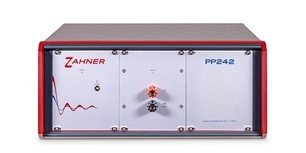 The PP242 is a 4-quadrant power potentiostat designed to apply and sink high currents up to ±40 A at a voltage range of up to ±5 V (max. power output 200 W).
The PP242 is a 4-quadrant power potentiostat designed to apply and sink high currents up to ±40 A at a voltage range of up to ±5 V (max. power output 200 W).For medium power applications, the PP242 is used as an extension of the ZENNIUM series potentiostat. Most electrochemical techniques which can be performed with the main ZENNIUM potentiostat can also be carried out with the extended power potentiostat PP242 setup.
Besides an extension, the PP242 power potentiostat can also be used in stand-alone mode for standard DC measurements i.e., charging/discharging of batteries. Zahner's new Zahner Lab software controls the potentiostat during stand-alone operations.
The Zahner's power potentiostats can be incorporated in a Python lab environment and can be used as stand-alone or in multi-channel configurations. A GitHub repository with examples is available for developing Python applications.
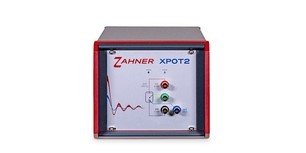 The XPOT2 as a high precision auxiliary potentiostat adds an additional channel to the ZENNIUM series potentiostat for bi-potentiostat functionality. The combination of ZENNIUM and XPOT2 enables rotating ring disk electrode (RRDE) measurements or hydrogen permeation in Devanathan cells. The XPOT2 provides up to ±500 mA output current and up to ±25 V compliance voltage. The XPOT2 contains 9 current ranges which enable it to carry out outstandingly precise and accurate measurements.
The XPOT2 as a high precision auxiliary potentiostat adds an additional channel to the ZENNIUM series potentiostat for bi-potentiostat functionality. The combination of ZENNIUM and XPOT2 enables rotating ring disk electrode (RRDE) measurements or hydrogen permeation in Devanathan cells. The XPOT2 provides up to ±500 mA output current and up to ±25 V compliance voltage. The XPOT2 contains 9 current ranges which enable it to carry out outstandingly precise and accurate measurements.In addition, the XPOT2 potentiostat can also be used as a standalone potentiostat and can be controlled by Zahner-Lab.
The Zahner's potentiostats can be incorporated in a Python lab environment and can be used as stand-alone or in multi-channel configurations. A GitHub repository with examples is available for developing Python applications.
For high power applications, it is possible to extend the ZENNIUM X potentiostat with our dynamic electronic loads (EL300/EL1000) for high power applications. Measurements with current up to 680 A can be carried out for stack with voltages of up to 100 V. Sine excitation of up to 1 kW can realize precise EIS measurements on large fuel cell, electrolyzer and battery system.
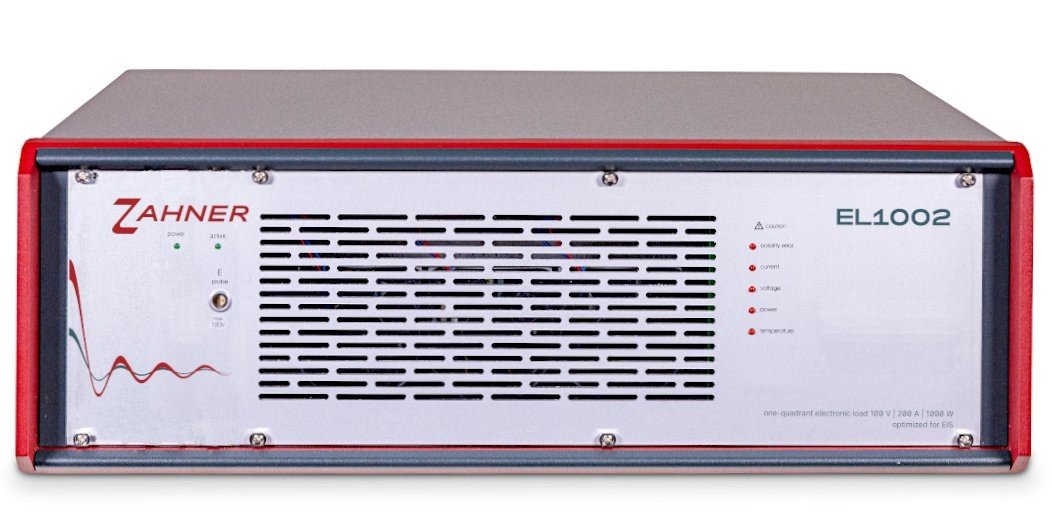
Photovoltaic/Photoeletrochemical
 Zahner's CIMPS is a highly dynamic LED-based system with an active light feedback loop that ensures a controlled and constant light intensity during the photoelectrochemical or photovoltaic measurements. Fast light sources enable dynamic photoelectrochemical measurements like IMPS/IMVS. The robust control of light intensity allows accurate IMPS/IMVS measurements, giving the system its iconic name "controlled intensity-modulated photo spectroscopy (CIMPS)". Further information on our light feedback loop and its benefits is provided in the manuscript "C in CIMPS".
Zahner's CIMPS is a highly dynamic LED-based system with an active light feedback loop that ensures a controlled and constant light intensity during the photoelectrochemical or photovoltaic measurements. Fast light sources enable dynamic photoelectrochemical measurements like IMPS/IMVS. The robust control of light intensity allows accurate IMPS/IMVS measurements, giving the system its iconic name "controlled intensity-modulated photo spectroscopy (CIMPS)". Further information on our light feedback loop and its benefits is provided in the manuscript "C in CIMPS".
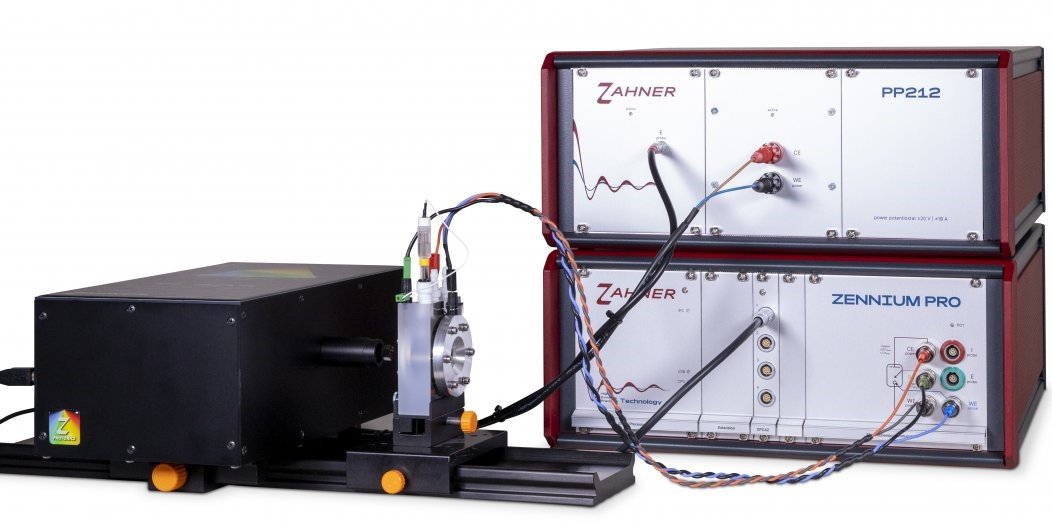 CIMPS-QE/IPCE is an extended CIMPS system with the capability to measure quantum efficiency (QE) or incident photon to current efficiency (IPCE). The CIMPS-QE/IPCE extension consists of an easily mountable and portable tuneable light source (TLS). The TLS contains dynamic LEDs, a monochromator and a feedback control which allow accurate light illumination during the measurements without any warm up time.
CIMPS-QE/IPCE is an extended CIMPS system with the capability to measure quantum efficiency (QE) or incident photon to current efficiency (IPCE). The CIMPS-QE/IPCE extension consists of an easily mountable and portable tuneable light source (TLS). The TLS contains dynamic LEDs, a monochromator and a feedback control which allow accurate light illumination during the measurements without any warm up time.Multiple LEDs in the TLS provide higher light intensity across the broad wavelength range and longer operational lifetime as compared to any traditional Xe-lamp. This high light intensity is crucial for IPCE measurements on DSSC, perovskites or organic solar cells or photoelectrodes.
Like the modular LEDs used in the CIMPS system, the TLS is also able to carry out sine-wave modulation for IPCE measurements and does not require a mechanical chopper. During IPCE measurements, a special indicator is also provided which indicates if the measurement parameters are optimum for IPCE measurement or not. Further information about IPCE measurement is provided in our application note CIMPS-IPCE.
Zahner offers TLS with two different wavelength ranges: 365 nm - 1020 nm and 290 nm - 1020 nm (with UV extension)
Options
Probes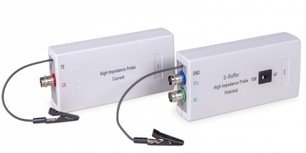 Equip your ZENNIUM X potentiostat with dedicated accessories for your required experiments like high impedance measurements (up to G?), low impedance measurements (down to µ?) or high voltage measurements (up to 100 V) etc.
Equip your ZENNIUM X potentiostat with dedicated accessories for your required experiments like high impedance measurements (up to G?), low impedance measurements (down to µ?) or high voltage measurements (up to 100 V) etc.The HiZ-Probe is designed for high impedance and ultra-low current measurements. It has an input impedance of 1000 T? || 1 pF. The HiZ-Probe consists of two I- and U boxes which should be kept inside a Faraday Cage, close to the test object. The cables connecting the HiZ-Probe to the ZENNIUM potentiostat are actively shielded. This configuration ensures the best protection from electrical disturbance from surrounding and mitigates artefacts induced during high impedance and low current measurements.
Typical applications are investigations on passive layers, oxides, nitrides, dielectric films, ceramic substrates, low conductive electrolytes, lacquers, coatings and microelectrodes etc.
 The LoZ-Cable is specially designed for low impedance measurements. The symmetric geometry of the cables optimally reduces the influence of mutual induction.
The LoZ-Cable is specially designed for low impedance measurements. The symmetric geometry of the cables optimally reduces the influence of mutual induction.The length of LoZ-Cable should be modified to the possible shortest length to minimize the artefacts. User-defined lengths are available on request.
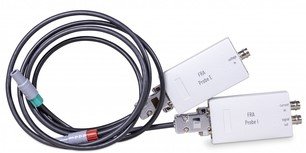 The FRA-Probe interfaces a third-party potentiostat or an electronic load to a ZENNIUM series potentiostat. The probe allows ZENNIUM potentiostats to modulate the current or voltage signal of third party potentiostats and carry out EIS measurements. The FRA-Probe allows ZENNIUM users to expand the power range to unlimited scales enabling EIS measurements on extreme samples like full stack fuel cells.
The FRA-Probe interfaces a third-party potentiostat or an electronic load to a ZENNIUM series potentiostat. The probe allows ZENNIUM potentiostats to modulate the current or voltage signal of third party potentiostats and carry out EIS measurements. The FRA-Probe allows ZENNIUM users to expand the power range to unlimited scales enabling EIS measurements on extreme samples like full stack fuel cells.The third party potentiostat or the electronic load must provide an analog control input and analog signal outputs for use with the FRA-Probe.
The FRA-Probe interfaced setup can also be incorporated in a Python lab environment and can be controlled remotely.
Addon Cards
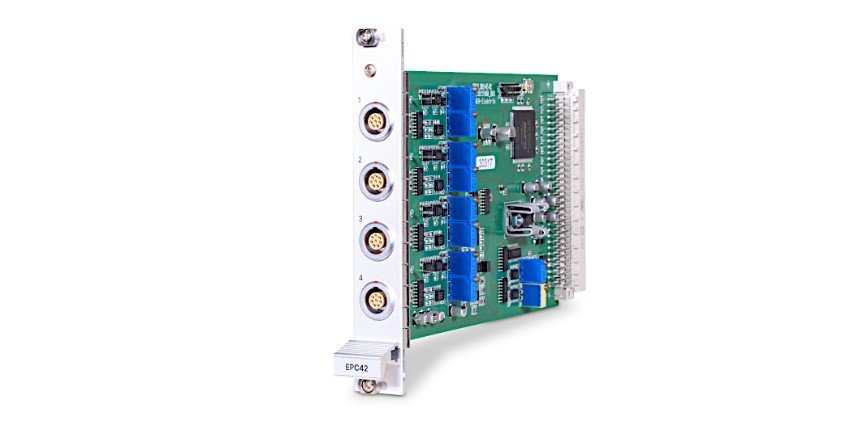 The functionality of the ZENNIUM X potentiostat can be extended with addon cards. With the addon cards additional analog and digital in- & output singals can be processed; power ranges can be optimized and extended.
The functionality of the ZENNIUM X potentiostat can be extended with addon cards. With the addon cards additional analog and digital in- & output singals can be processed; power ranges can be optimized and extended.The EPC42 is the link between the ZENNIUM potentiostat and the power and auxiliary potentiostats or electronic loads. One EPC42 card can address up to four PP/EL/XPOT devices sequentially. Up to four EPC42 cards can be installed in a ZENNIUM X and ZENNIUM PRO potentiostat. In total, a ZENNIUM series potentiostat can be simultaneously connected with up to 16 external PPs/ELs, which can be controlled sequentially.
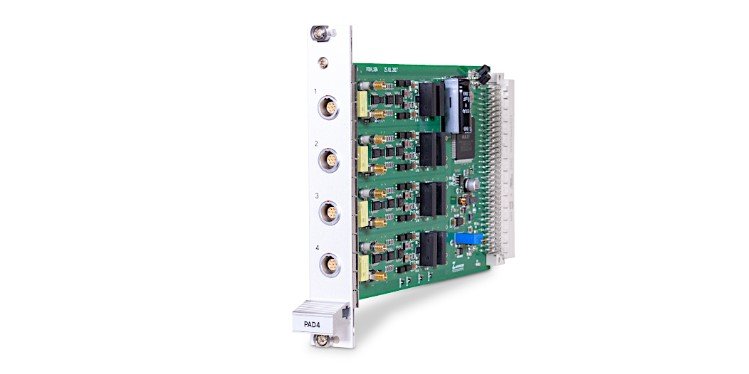 The Zahner PAD4 card provides 4 additional voltage or current input channels which can be used for parallel DC or EIS measurements on segments connected in series. The PAD4 card is an optimal addition to the ZENNIUM potentiostat for stack measurements or segmented cells.
The Zahner PAD4 card provides 4 additional voltage or current input channels which can be used for parallel DC or EIS measurements on segments connected in series. The PAD4 card is an optimal addition to the ZENNIUM potentiostat for stack measurements or segmented cells.The PAD4 card is used in the fuel cell, electrolyzer stack and battery-pack investigations. In addition, it is used in measurements involving a reference electrode in a 3-electrode cell connection scheme.
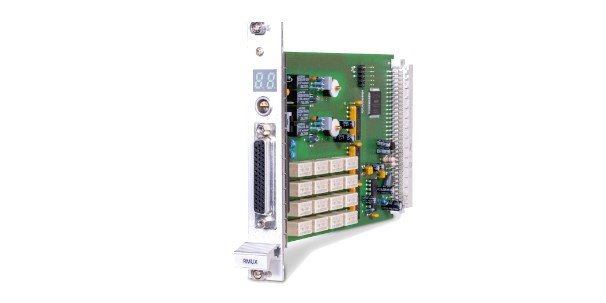 The RMUX16 card allows to simultaneously connect up to 16 individual cells to the potentiostat. Up to four RMUX16 cards can be installed in a ZENNIUM series potentiostat which allows simultaneous connection to up to 64 electrochemical cells. The measurements on all connected cells are carried out sequentially. The RMUX16 card is an ideal addition for routine and screening measurements on small samples.
The RMUX16 card allows to simultaneously connect up to 16 individual cells to the potentiostat. Up to four RMUX16 cards can be installed in a ZENNIUM series potentiostat which allows simultaneous connection to up to 64 electrochemical cells. The measurements on all connected cells are carried out sequentially. The RMUX16 card is an ideal addition for routine and screening measurements on small samples.Multiplexer
Multiplexer simultaneously connects multiple test objects i.e., cells, with the ZENNIUM X potentiostat and allows sequential measurements on the connected cells. The automatic sequential measurements on several cells lead to significant increase in productivity and aid in automating the measurement rountines.
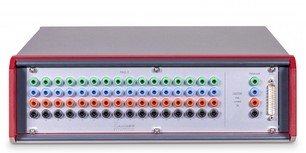 The PMUX-S power multiplexer is used to simultaneously contact the ZENNIUM series potentiostat with up to 16 individual cells. The measurements are carried out sequentially. For medium power applications, our power potentiostats can also be connected. The PMUX-S can be used for cell currents up to ±5 A.
The PMUX-S power multiplexer is used to simultaneously contact the ZENNIUM series potentiostat with up to 16 individual cells. The measurements are carried out sequentially. For medium power applications, our power potentiostats can also be connected. The PMUX-S can be used for cell currents up to ±5 A.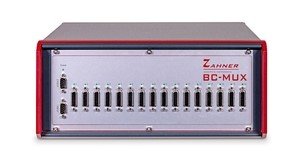 The battery cycling multiplexer BC-MUX is the link between the high power performances of your battery cycler and the EIS precision of our ZENNIUM potentiostats. The BC-MUX can address up to 16 channels to sequentially perform EIS measurements on the connected samples.
The battery cycling multiplexer BC-MUX is the link between the high power performances of your battery cycler and the EIS precision of our ZENNIUM potentiostats. The BC-MUX can address up to 16 channels to sequentially perform EIS measurements on the connected samples.Switchboxes which serve as ports between the BC-MUX and the cycler are available as 12 A, 60 A, 150 A or custom made options.






